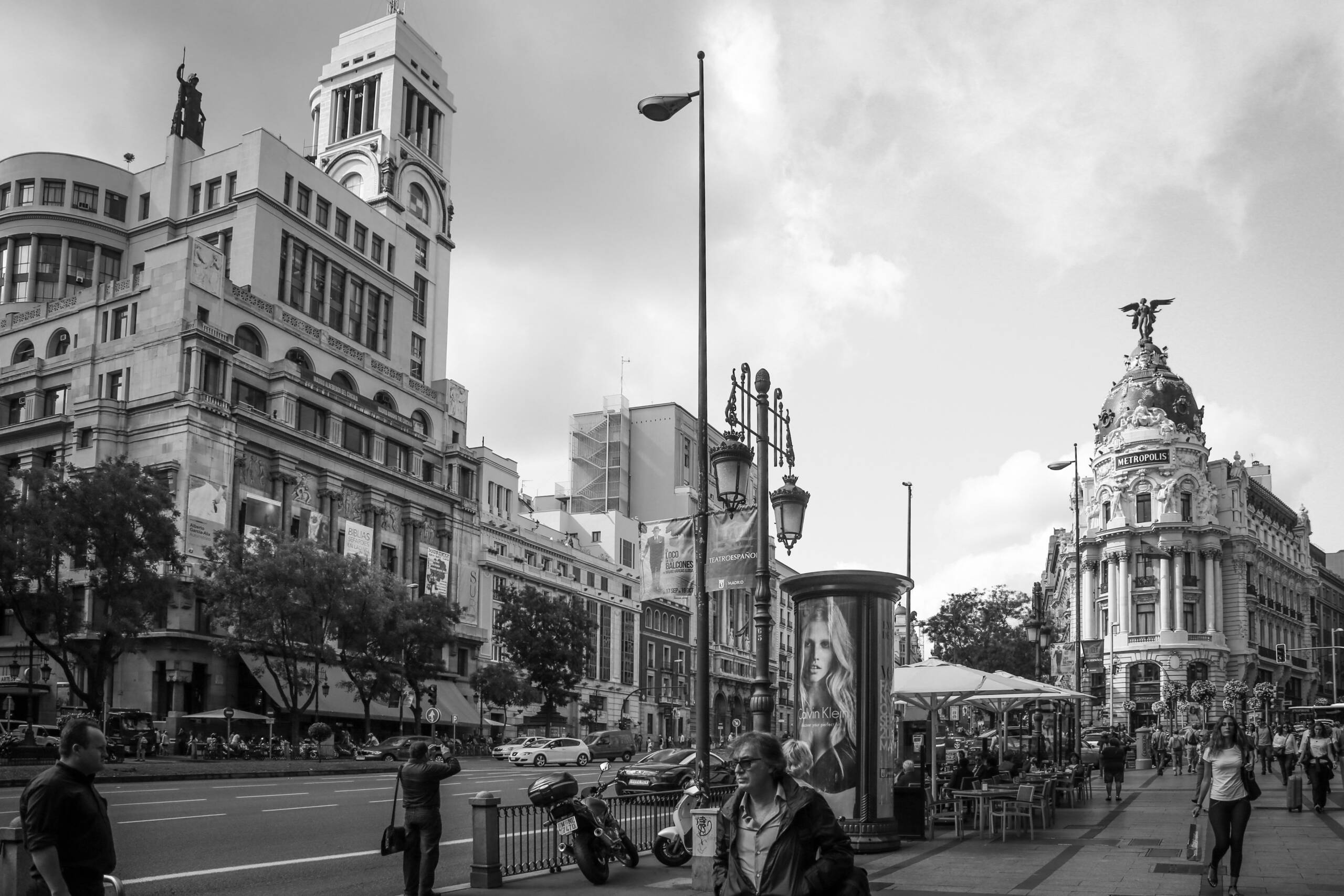There is something timeless about stripping a city of its color and leaving it to reveal itself only through light, shadow, and form. This photograph of Madrid’s Gran Vía, rendered in black and white, shows the city as more than a tourist postcard. The iconic Metropolis building, crowned with its winged statue, dominates the frame with its ornate dome and sculptural flourishes, but it does not stand alone. It competes visually with the lampposts rising elegantly in the foreground, their ironwork echoing the artistry of the facades behind them. To the left, a monumental stone building climbs skyward, its tower capped with a figure silhouetted against the bright Spanish sky. The billboard advertisement—here a Calvin Klein poster—sits beside the architectural giants without shouting, its tones muted into the same monochromatic register. In this rendering, pedestrians, cafés, cars, and even shop signs carry equal visual weight. Black and white flattens the hierarchy between the monumental and the mundane, allowing the city to emerge as a cohesive whole rather than a competition of colors.

Travel photography often leans on the seduction of color—sunset reds spilling across tiled rooftops, summer dresses catching the eye, or the amber glow of a café terrace—but once you strip the palette away, what remains is the skeleton of the city: light carving through stone, shadows slicing across pavement, forms balanced in a rhythm the eye might otherwise overlook. In Madrid, the architectural density of Gran Vía emerges more clearly when the distractions of neon signs, painted facades, and advertising are removed. The lines of windows march across the frame in sequence, broken only by trees, lampposts, and the occasional figure stepping into sunlight. The photograph becomes a study in geometry, in the collision of vertical towers with horizontal boulevards, and in the contrasts between permanence and motion.
Expanding the gaze across the image, details emerge that are easy to miss when overwhelmed by color. A man stands in the lower left corner, his head tilted back, camera in hand, framing his own version of the scene. Others cross casually into the street, some rushing, some pausing, their movement caught as mid-tones against the deep shadows under awnings. Café tables spill onto the sidewalk, umbrellas casting patterned shade, while motorbikes and cars line the curb, their metallic surfaces reflecting the same light that gilds the Metropolis dome. By rendering it all in black and white, the photograph creates a democracy of vision—no single element screams louder than the others. Instead, the city breathes as one.
Technically, shooting with black and white in mind requires a shift in perception. It is not simply about draining color in post-production, but about anticipating tonal contrast before pressing the shutter. A bright, overcast sky that might wash out a color photo becomes an advantage in monochrome, supplying an even glow that highlights stone textures and architectural detail. Deep shadows that might conceal a doorway in color become the very elements that structure the frame, grounding it with visual weight. For this image, a wide lens captures both the Metropolis building and its neighboring towers in a single sweep, while an aperture of f/8 ensures clarity from foreground to skyline. A low ISO—200 or 400 in daylight—locks in fine textures: the worn cobblestones, the carved ornamentation, the billboards layered over facades. In editing, the work lies not in desaturation but in balancing contrast, ensuring that every shade of grey feels intentional, from the palest sky to the deepest shadow under a balcony.
Yet the true power of black and white travel photography is not technical but emotional. A city seen this way feels less like a fleeting snapshot of today and more like a continuum across time. A scene captured in 2025 might recall photographs from the 1950s or even the 1930s, when Gran Vía was already the artery of Madrid’s modern life. The rhythms of pausing, crossing, conversing, and watching remain unchanged. By stripping away color, you allow the city to slip free from its timestamp, to feel both contemporary and archival at once. The viewer is left to imagine the season, the atmosphere, even the voices echoing through the street.
That is why Madrid lends itself so naturally to monochrome. Gran Vía is not just a boulevard but a theater where architecture and humanity share the stage. The stone facades carry the weight of history, but the constant tide of pedestrians and vehicles provides motion and impermanence. Black and white captures both forces at once, making the city feel like a film set caught between grandeur and intimacy. To photograph Madrid this way is to step beyond color’s easy seduction and into the deeper structure of what makes the city alive. It is not only about where you stand with a camera, but about what it feels like to be there—immersed in a rhythm of light, shadow, and form that has defined Madrid for generations.
Leave a Reply